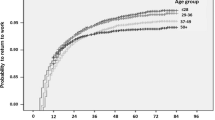Abstract
Introduction: The objective of this study was to investigate the influence of accidents, the physical and psychological consequences, the patient’s predisposition as well as work-related cognitions on return to work (RTW) post accident. Despite the costs of time-off from work after accidental injuries, very few investigations have been carried out so far. Method: In a consecutive sample, 163 patients were investigated directly and 12 months after an accident. Results: 32% of the patients had a poor occupational integration 12 months after an accident. As predictors for return to work were found type of prior work: laborer (OR=4.34; 1.79–10.50 CI 95%), type of accident: recreational (OR=0.27; 0.11–0.69 CI 95%) and subjective perception of the accident severity (OR=0.98; 0.96–0.99 CI 95%). Conclusion: Laborers after a traffic or work accident, who estimate the accident as severe, are at greater risk of developping long-term disability. Future efforts should be conducted especially for this target group.
Similar content being viewed by others
References
O’Donnell ML, Creamer M, Pattison P. Posttraumatic stress disorder and depression following trauma: Understanding comobidity. Am J Psychiatry 2004;161:1390–6.
Pransky G, Gatchel R, Linton S, Loisel P. Improving return-to-work research. J Occup Rehabil 2005;15:453–7.
Young AE, Roessler RT, Wasiak R, McPherson KM, van Poppel MNM, Anema JR. A developmental conceptualization of return to work. J Occup Rehabil 2005;15:557–67.
Sullivan MJL, Feuerstein M, Gatchel R, Linton SJ, Pransky G. Integrating psychosocial and behavioral interventions to achieve optimal rehabilitation outcomes. J Occup Rehabil 2005;15:475–89.
Vingard E, Mortimer M, Wiktorin C, Persnold RPTG, Frederiksson K, Nemeth G, et al. Seeking care for low back pain in the general population: A two-year follow-up study. Spine 2002;27:2159–65.
Chernen L, Friedman S, Goldberg N, Feit A, Kwan T, Stein R. Cardiac disease and nonorganic chest pain: Factors leading to disability. Cardiology 1995;86:15–21.
Linton SJ, Gross D, Schultz IZ, Main C, Cote P, Pransky G, Johnson W. Prognosis and the identification of workers risking disability: research issues and directions for further research. J Occup Rehabil 2005;15:459–74.
Andersson A, Bunketorp O, Allebeck P. High rates of psychosocial complications after road traffic injuries. Injury 1997;28:539–43.
Schnyder U, Moergli H, Klaghofer R, Sensky T, Buchi S. Does patient cognition predict time off from work after life-threatening accidents? Am J Psychiatry 2003;160:2025–31.
Linton SJ. Occupational psychological factors incrase the risk for back pain: a systematic review. J Occup Rehabil 2002;11:53–66.
Miller H. Accident Neurosis. Br Med J 1961;1:919–25.
Thompson G. Post-traumatic psychoneurosis: A statistical survey. Am J Psychiatry 1965;121:1043–8.
Blanchard EB, Hickling EJ, Taylor AE, et al. Effects of litigation settlements on posttraumatic stress symptoms in motor vehicle accident victims. J Trauma Stress 1998;11:337–54.
Cornes P. Return to work of road accident victims claiming compensation for personal injury. Injury 1992;23:234–5.
Michaels AJ, Michaels CE, Moon C, et al. Psychosocial factors limit outcomes after trauma. J Trauma 1998;44:644–8.
Meyer C, Steil R. Post-traumatic stress disorder after traffic accidents. Unfallchirurg 1998;101:878–93.
Buist-Bouwman MA, De Graaf R, Vollebergh WAM, Ormel RMEL J. Comorbidity of physical and mental disorders and the effect on work-loss days. Acta Psychiatr Scand 2005;111:436–43.
Wittchen H, Wunderlich U, Gruschwitz S, Zaudig M. Strukturiertes klinisches interview für DSM-IV (SKID-I Und SKID-II) Hogrefe, Göttingen; 1997.
First MB, Gibbon M, Spitzer RL, Williemas JBW. Users guide for structured clinical interview for DSM-IV axis I disorders (SCID) Biometrics Research, New York, 1996.
First MB, Spitzer RL, Gibbon M, WIilliams JBW. User's guide for the structured clinical interview for DSM-IV personality disorders (SCID-II) Washington DC. American Psychiatric Press 1996.
Antonovsky A. The structur and properties of the sense of coherence scale. Soc Sc Med 1993;36:725–33.
Baker S, O’Neill B. The Injury Severity Score: An update. J Trauma 1976;16:882–5.
Blake DD, Weathers FW, Nagy LM, et al. The development of a clinician-administered PTSD scale. J Trauma Stress 1995;8:75–90.
Franke GH. Brief Symptom Inventory (BSI) Hogrefe, Göttingen, 2000.
Bruyns CNP, Jaquet JB, Schreiders TAR, et al. Predictors for return to work in patients with median and ulnar nerve injuries. J Hand Surg 2003;28:28–34.
Hickling E, Blanchard E, Silverman D, Schwarz S. Motor vehicle accidents, headaches and post-traumatic stress disorder: assessment findings in a consecutive series. Headache 1992;32:147–51.
Blanchard EB, Hickling EJ, Taylor AE, Loos WR. Psychological Morbidity Associated With Motor Vehicle Accident. Behav Res Ther 1994;32:283–90.
Acknowledgements
This study was supported by the Federation of German Pension Insurance (project number: FKZ 02210). Parts of the results had been presented at “The 9th European Conference on Traumatic Stress,” Stockholm, Sweden, June 18–21, 2005.
Author information
Authors and Affiliations
Corresponding author
Additional information
Corinna Lange and Markus Burgmer contributed equally to the present work and should therefore both be considered as first authors.
Rights and permissions
About this article
Cite this article
Lange, C., Burgmer, M., Braunheim, M. et al. Prospective Analysis of Factors Associated with Work Reentry in Patients with Accident-Related Injuries. J Occup Rehabil 17, 1–10 (2007). https://doi.org/10.1007/s10926-006-9039-y
Published:
Issue Date:
DOI: https://doi.org/10.1007/s10926-006-9039-y




